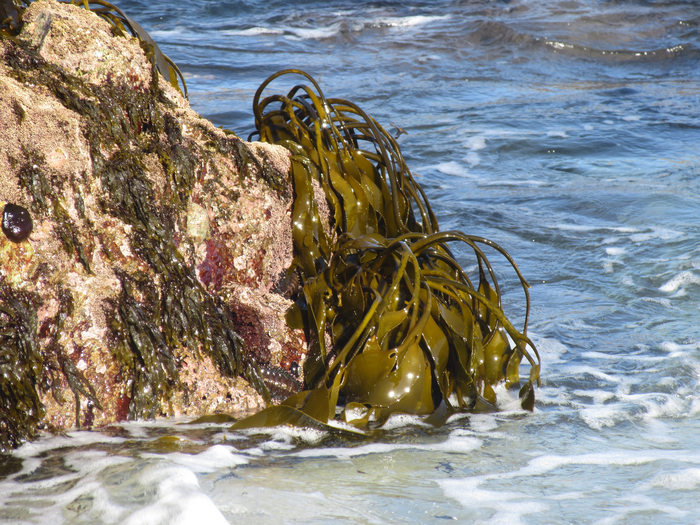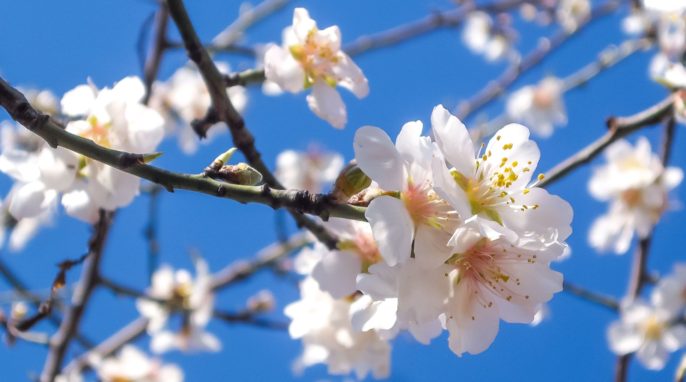Mucus produced by brown algae may be the key to protecting the ocean, as a new study uncovers how carbon dioxide gets captured and converted.
By Vaishnavi Sridhar
Years ago when Columbus and his group were on their first voyage, at a stretch in the Atlantic Ocean, his ships got stuck in what appeared to be a meadow. A meadow in the ocean? What could this be? The sailors were scared and thought that this meadow was covering dangerous rocks! This area was nothing but the Sargasso Sea, a sea in the Atlantic Ocean, the only sea without a land boundary. This sea is named after Sargassum, a type of brown algae.
What is algae? Algae are organisms capable of photosynthesis or making their own food. Algae convert carbon dioxide to carbohydrates (carbon fixing) similar to plants. They are mostly found in aquatic environments and have many types, including brown algae such as kelp. Brown algae can fix more carbon per area than forests on land. Carbon fixing ensures that carbon dioxide is captured from the atmosphere and can help regulate carbon dioxide levels in the atmosphere. Since carbon dioxide is a greenhouse gas, regulating carbon dioxide levels helps regulate global temperature.
Carbohydrates are mainly used as an energy source and for maintaining the structure of algae. Brown algae produce various carbohydrates such as laminarin, cellulose, alginate, and fucoidan. Fucoidan is a part of the brown algae extracellular matrix (mucus-like protective barrier) and is also secreted into seawater. It serves protective functions, as it cannot be broken down easily by bacteria. Carbohydrates produced by algae can be broken down and used by other organisms or can persist without being broken down. Fucoidan has been found to persist for centuries in sediments in the deep sea. What this means is that carbon can be stored for a long term in the form of fucoidan.
How much carbon is contained in these carbohydrates, how much fucoidan is secreted, and what conditions influence this process have been unanswered questions for microbiologists. In a new study from the Max Planck Institute for Marine Microbiology, Hagen Buck-Wiese and colleagues used various methods to analyze fucoidan secretion into seawater. They found that fucoidan contains very few essential nutrients and is secreted at higher levels in the presence of light. Their research findings suggest that fucoidan secretion presents an impactful way in which brown algae capture carbon dioxide, without any nutrient loss.
New findings on brown algae mucus
In their study—published in the academic journal PNAS—Buck-Wiese and fellow researchers set out to analyze the amount of fucoidan secreted by brown algae into seawater and the conditions that influence it. For this, the scientists grew a kind of brown algae called Fucus vesiculosus in the coastal Baltic Sea for over 5 hours in transparent or dark bags. They collected seawater around the algae from these bags and analyzed it using various techniques.
They found carbohydrates and other nutrients in the collected seawater. More carbohydrates were secreted in the presence of light, which they expected since light is required for photosynthesis, and photosynthesis enables the production of carbohydrates. To examine the complex carbohydrates present in this collected seawater, the researchers used a combination of techniques. Combining techniques gives multi-fold information about the carbohydrates, including the kinds present, the properties of these, their composition, and their levels present.
In one of these techniques, the presence of fucoidan was detected indirectly by measuring the breakdown products of fucoidan in a lab setting. The breakdown products will be present only if fucoidan is present in the seawater. The researchers used a probe to detect the presence of fucoidan directly in the seawater and found that fucoidan comprised up to 50 percent of the carbohydrates in the collected seawater.
Growing the algae in the presence of light resulted in a greater secretion of fucoidan. Fucoidan is composed mainly of hydrogen, carbon, and sulfur, and is thus a sulfur-containing carbohydrate. Fucoidan hardly contains any nitrogen, which is important for the growth of algae. Fucoidan secretion thus requires light and carbon dioxide, but doesn’t use up the nitrogen reserves of algae. Therefore, brown algae can secrete fucoidan without any effects on their growth. This is important because algae are the primary producers and the starting point for marine food chains, so any changes in their growth levels can affect various organisms. However, fucoidan secretion occurs without any significant use of the important nutrient reserves of brown algae and hence doesn’t impact growth levels.
RELATED: Read about algae that glows, in Bioluminescence: Why Dazzling Blue Lights Appear in Water
In the case of most photosynthesizing organisms, the carbohydrates made during photosynthesis get used up and cycle between organisms. However, it has been found that fucoidan cannot be broken down easily in nature, although it can reach the deep sea and can be stored as sediments. As a greenhouse gas, large amounts of carbon dioxide can lead to global warming, ocean acidification, and other problems for the environment. Fucoidan secretion can capture significant amounts of this carbon dioxide from the atmosphere to regulate global temperatures, without significantly affecting the nutrient levels of brown algae and hence the ocean ecosystem.
Fucoidan secretion hence presents a way by which brown algae can be used to capture carbon dioxide, without a significant removal of nutrients from the ocean ecosystem. However, more studies would need to be done on different kinds of brown algae, in different geographic locations, under different environmental conditions, and over a larger period of time to learn more about fucoidan secretion.
This research article was published in the peer-reviewed journal PNAS.
References
Bligh, M., Nguyen, N., Buck-Wiese, H., Vidal-Melgosa, S., & Hehemann, J. H. (2022). Structures and functions of algal glycans shape their capacity to sequester carbon in the ocean. Current Opinion in Chemical Biology, 71, 102204. https://doi.org/10.1016/j.cbpa.2022.102204
Buck-Wiese, H., Andskog, M. A., Nguyen, N. P., Bligh, M., Asmala, E., Vidal-Melgosa, S., Liebeke, M., Gustafsson, C., & Hehemann, J. H. (2022). Fucoid brown algae inject fucoidan carbon into the ocean. Proceedings of the National Academy of Sciences, 120(1), e2210561119. https://doi.org/10.1073/pnas.2210561119
Kiselevskiy, M. V., Anisimova, N. Y., Ustyuzhanina, N. E., Vinnitskiy, D. Z., Tokatly, A. I., Reshetnikova, V. V., Chikileva, I. O., Shubina, I. Z., Kirgizov, K. I., & Nifantiev, N. E. (2022). Perspectives for the use of fucoidans in clinical oncology. International Journal of Molecular Sciences, 23(19), 11821. https://doi.org/10.3390/ijms231911821
National Oceanic and Atmospheric Administration. (2021, January 4). What is the Sargasso Sea? National Ocean Service. https://oceanservice.noaa.gov/facts/sargassosea.html
The Sargasso Sea. (1881). In E. H. Gibbs (ed.), Hall’s Journal of Health, 28(7), 274.




